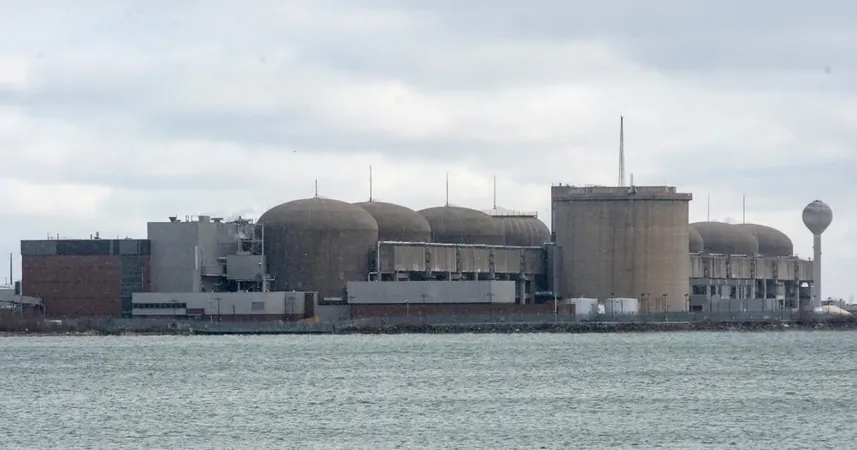
Ontario's Ambitious Nuclear Power Plan: A Game Changer for Energy Demand?
2025-01-16
Author: Olivia
Introduction
Ontario is set to expand its nuclear energy capacity significantly in response to projected electricity demands that are expected to soar by 75% by 2050. In a recent announcement, Energy Minister Stephen Lecce unveiled plans to explore the development of a new nuclear power plant at the Ontario Power Generation's Wesleyville site near Port Hope.
Strategic Alignment
This initiative aligns with Premier Doug Ford's broader strategy to foster stronger trade relations with the U.S., especially in light of recent tariff threats from president-elect Donald Trump. The proposed energy plan aims to enhance Ontario's existing nuclear infrastructure to boost electricity exports to the United States.
Expert Opinions
Experts are optimistic about the potential of nuclear energy in the transition to sustainable energy sources. Currently, three of Canada's four operational nuclear power plants are situated in Ontario, marking the province as a key player in this sector.
"Nuclear is destined to be a cornerstone of Canada's future power generation, especially with the rise of technology, data centers, and artificial intelligence," stated Francis Syms, Associate Dean of Information and Communications Technology at Humber Polytechnic. He emphasized that a small modular reactor (SMR) could provide sufficient power for approximately 237,000 homes annually—a significant contribution to the grid.
Fortress Am-Can Plan
Ford's "Fortress Am-Can" plan seeks not only to expand the electricity grid shared with the U.S. but also to simplify the approval process for developing both small modular reactors and larger nuclear facilities. Jason Dion, Senior Research Director with the Canadian Climate Institute, highlighted the necessity for Ontario's electrical grid to adapt and grow in anticipation of future demand.
Dion praised the province's comprehensive approach, stating, "Ontario is investing across the board in electricity systems—this includes improving energy efficiency, refurbishing hydropower, integrating renewables, and expanding nuclear power."
Future Prospects
Using Canada's experienced CANDU reactors as a regulatory and operational framework, experts believe that Ontario can lead the charge for SMR development. "If we execute this promptly, not only can we meet our domestic energy needs, but we can also help other nations establish their own nuclear facilities," said Syms.
Moreover, Dion noted that Ontario's vast land and natural resources position it well for attracting further investment in diverse energy projects, such as electric vehicle manufacturing, battery plants, critical minerals, and hydrogen production. He stated, "Ontario is strategically maximizing its hydropower capabilities while also exploring various energy avenues necessary for the clean energy transition."
Conclusion
With Ford's "Fortress Am-Can" initiative, the potential for creating a secure and integrated energy generation network between Canada and the U.S. is immense. According to Syms, "Canada possesses the resources—minerals, land, water, and expertise—to establish this powerful energy network, all of which the U.S. is eager to tap into."
As Ontario embarks on this ambitious venture, its nuclear power plans not only aim to meet rising energy demands but also promise to position the province—and potentially Canada—as a global leader in sustainable energy. Will this be the turning point for Ontario’s energy future? Stay tuned!









 Brasil (PT)
Brasil (PT)
 Canada (EN)
Canada (EN)
 Chile (ES)
Chile (ES)
 Česko (CS)
Česko (CS)
 대한민국 (KO)
대한민국 (KO)
 España (ES)
España (ES)
 France (FR)
France (FR)
 Hong Kong (EN)
Hong Kong (EN)
 Italia (IT)
Italia (IT)
 日本 (JA)
日本 (JA)
 Magyarország (HU)
Magyarország (HU)
 Norge (NO)
Norge (NO)
 Polska (PL)
Polska (PL)
 Schweiz (DE)
Schweiz (DE)
 Singapore (EN)
Singapore (EN)
 Sverige (SV)
Sverige (SV)
 Suomi (FI)
Suomi (FI)
 Türkiye (TR)
Türkiye (TR)
 الإمارات العربية المتحدة (AR)
الإمارات العربية المتحدة (AR)